
by SUSAN M. BRACKNEY

As a kid, Steve Bodi scoured his Indiana surroundings for “pretty rocks” and fossils. “A fossil is a record of something that used to be alive and it’s locked in stone,” he says. “That was very intriguing to me.”
Today, the 58-year-old remains just as intrigued, and he still seeks pretty rocks—albeit on a much larger scale. “I’d been doing paleontology as a hobby for many years,” he explains. “Then it got more intense and became more of a passion.”
After co-owning Renaissance Rentals in Bloomington for nearly 30 years, Bodi retired early to pursue that passion. “We go out west to hunt for buried treasure—and sometimes we find it,” he says.
Hitting pay dirt means bringing dinosaur bones and other fossils back from the High Plains desert in the western United States to the Martinsville-based Southern Indiana Paleontology Institute (SIPI), a nonprofit organization Bodi founded in 2015. Equal parts fossil preparation lab and educational center, SIPI affords interns hands-on experience. “I teach them how to prepare fossils for display like they would be displayed in a museum,” he notes.
Bodi earned a B.S. from Indiana University’s School of Public and Environmental Affairs in 1985. “Paleontology was just a side thing I enjoyed,” he says. “But, if you had seen my office 20 years ago, it was full of rocks and things.”

Although largely self-taught, Bodi found valuable paleontology mentors at the Indianapolis Children’s Museum. “When I was just beginning, they’d invite me to go into their lab, use their equipment, and learn,” he says. He also went out west with them to find fossils.
Now, Bodi regularly braves the Badlands’ 111-degree heat, rattlesnakes, and even the occasional mountain lion on his own or with interns. “When you’re crouched down for a long time, you look like prey,” he says. “So, every once in a while, I get up and make myself look big. I’ll move my arms around, talk or sing, or do something stupid to create a bit of a commotion.”
One of his prized finds to date? A T-Rex’s baby tooth. “It’s only about 4 inches long,” he says. “With the girth and shape—it’s unmistakable. That was really a special moment, because that’s kind of the holy grail.”










